目次
はじめに
どうもポテトはカリカリ派の男、超川です。
「機械学習や生成AIの開発って、専門知識やPythonが必要なんでしょ…?」
そう思っている方にこそ試してほしいのが Amazon SageMaker JumpStart
クリックのポチポチ操作だけで事前学習済みAIモデルを簡単に試すことができます!
コーディングが苦手でも、「画像生成・感情分析・画像認識」などのAIをサクッと体験できます。
今回は、SageMaker JumpStartを使って画像生成AIを作成する、超シンプルなハンズオンをご紹介します。
SageMaker JumpStartとは?
まずはSageMaker JumpStartについてざっくり紹介します。
SageMaker JumpStartとは、AWSが提供する機械学習モデルのテンプレート集です。
600 を超える事前学習済みモデルが用意されており、コードを書かずにモデルのデプロイや推論ができます。
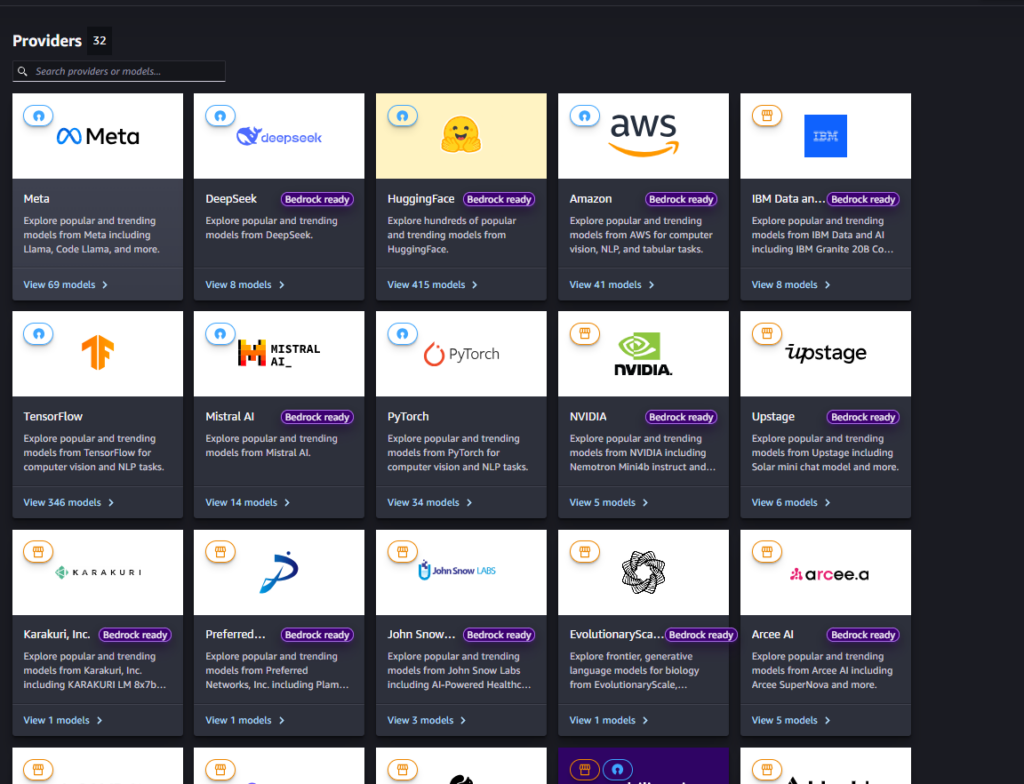
実際にやってみる
もっともっとSageMaker JumpStartの特徴や魅力はありますが、今回は尺の都合上ここまでにして...
さっそく実際にハンズオンを行っていきましょう!!
ステップ1:SageMaker Studioへアクセス
1-1.今すぐ始めるからSagemakerドメインの作成をクリック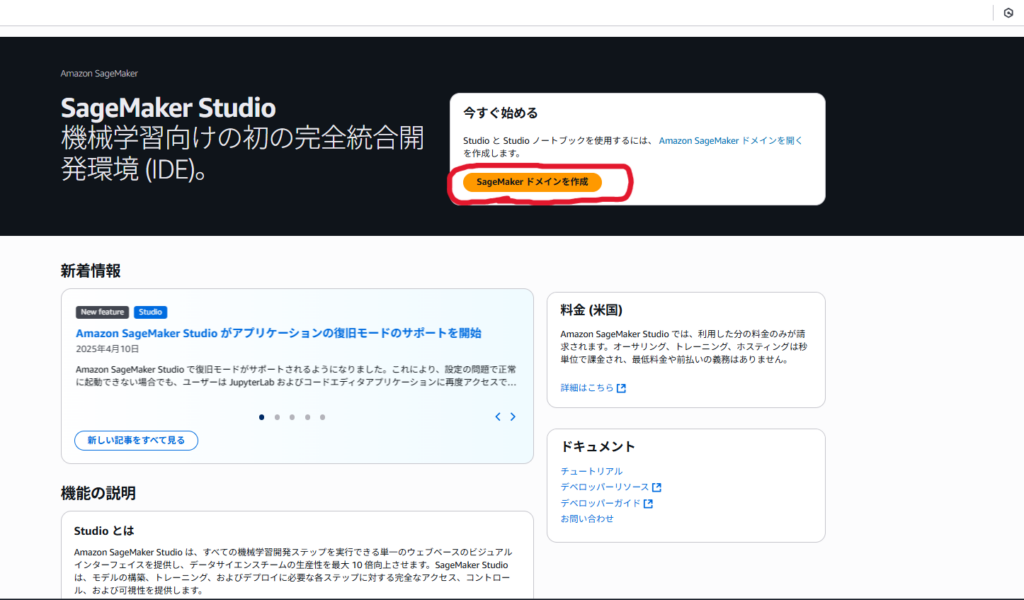
1-2.シングルユーザ向けの設定(クイックセットアップ)を選択し、設定をクリック。
しばらくすると「SageMaker Domainの準備ができました」と表示されます。
1-3.準備ができたら、先ほど作成したドメインを選択して「Studio を開く」をクリック
(ユーザプロファイルは今回はデフォルトを使用しています)

ステップ2:モデルを選択してエンドポイントをデプロイ
2-1.左メニューから「JumpStart」をクリック。
今回は「Stable Diffusion」を使用します。
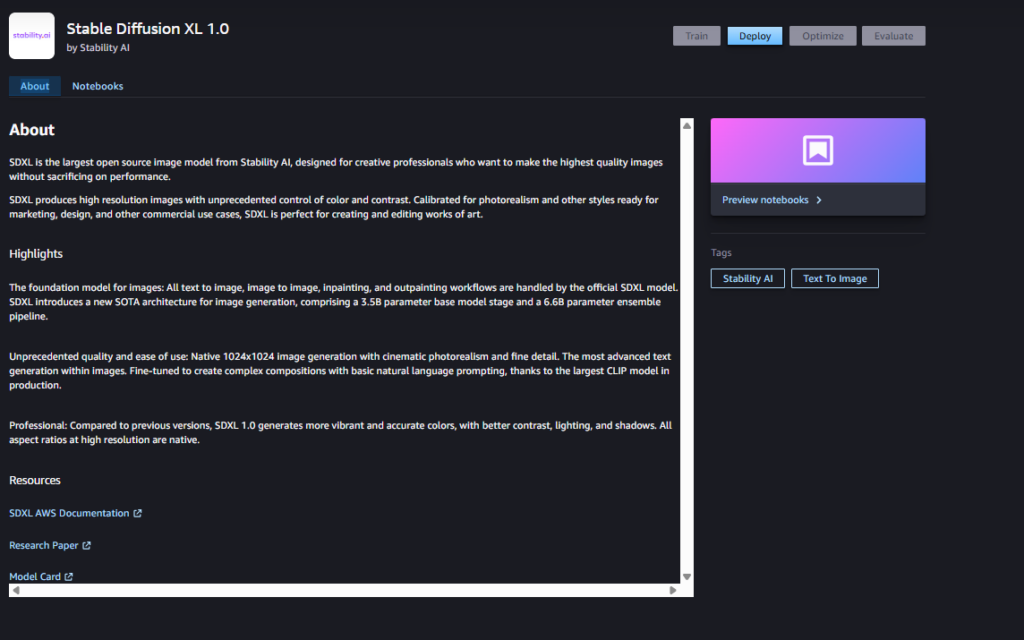
2-2.「Deploy」ボタンをクリック。
今回使用する「Stable Diffusion XL 1.0」はAWSマーケットプレイスのサブスクリプションが必要です。
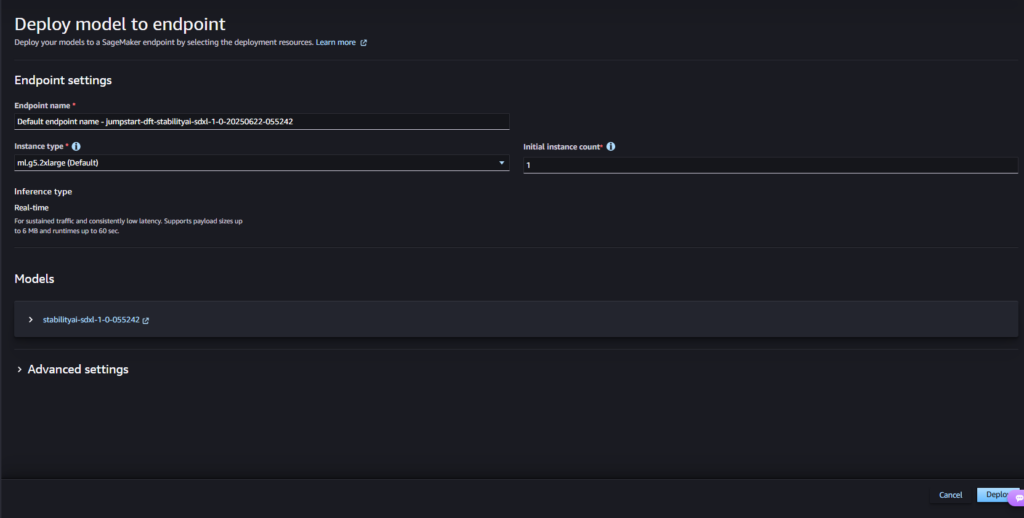
2-3.エンドポイント、インスタンスタイプ、インスタンス数を選びます。
通常は「インスタンス数: 1」で十分です。(複数は高可用性用)
数分待てば、エンドポイントがデプロイされました!
ハンズオン時に発生したエラー
今回、「ml.g5.2xlarge」があなたのアカウントでは使えない設定になっているというエラーが発生しました。
これは新規AWSアカウントでよく発生する問題だそうです。
①AWSのコンパネから「Service Quotas」に移動
↓
②AWSのサービスから「Amazon SageMaker」を選択
↓
②「ml.g5.2xlarge for endpoint usage」にチェックを入れて
クォータ引き上げをリクエスト(Request quota increase)」をクリックで解決
ステップ3:実際に動かしてみる
今回は簡単、簡潔に作成した生成AIをチャット風UIとして動かすために
Python SDKを使用します。
3-1.左カラムの「Deployments」タブの「Endpoints」から今回作成したエンドポイントをクリック
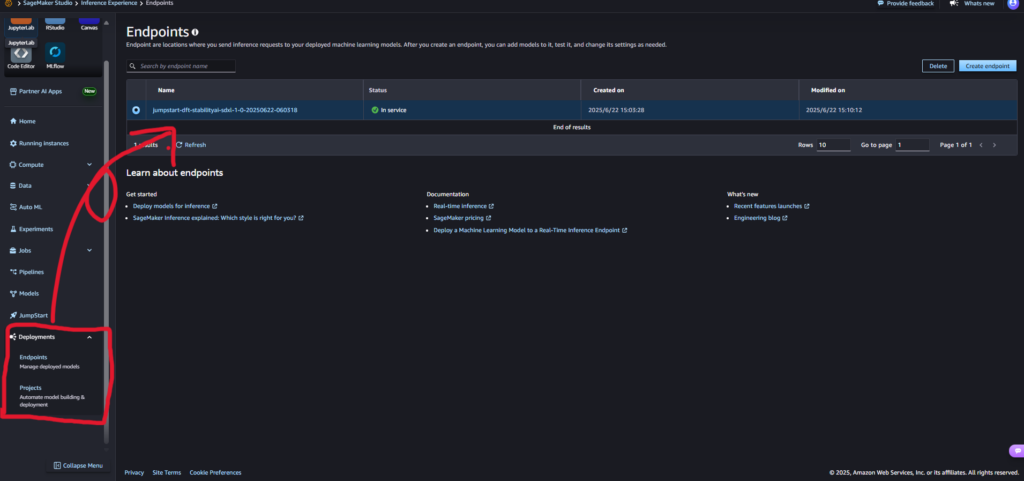
3-2.「Test inference」タブに移動。
3-3.「Use Python SDK example code」 を選択し、「Open in JupyterLab」 をクリックします。
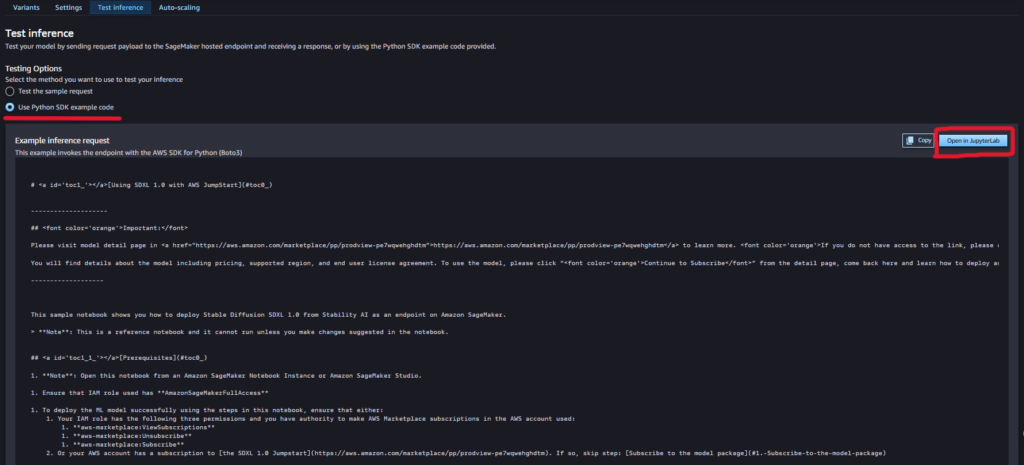
3-4.「Create new space」を選択して名前を入力。(今回はtestで作成)
右下の「Create space and Open notebook」をクリックして作成。

3-5.作成後、「Open in JupyterLab」から「Use existing space」を選択し、
先ほど作成したものをクリックするとJupyterLabのノートブックが開きます。
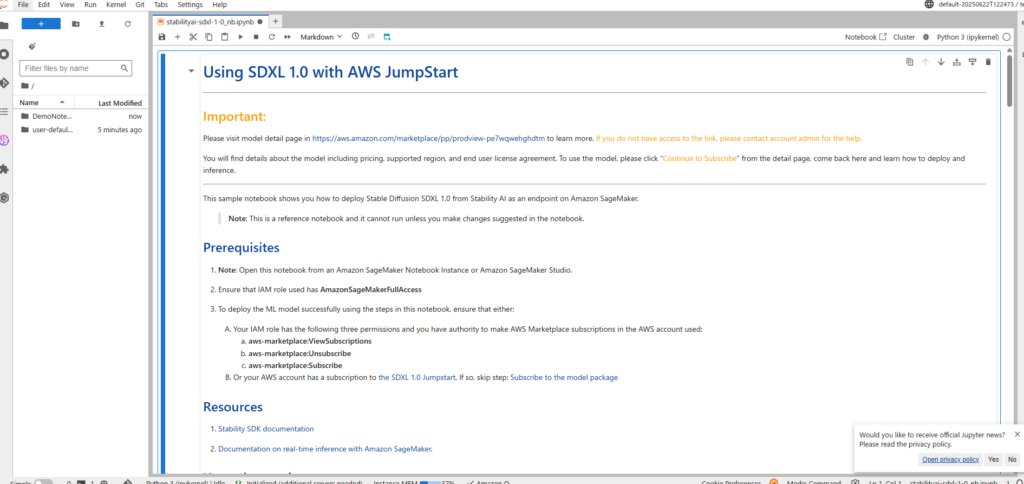
3-6.「+」ボタンで新しいセル作成し、
チャット風UIを作成するためのコードを貼り付け、Shift + Enter で実行
偉大なるChatGPT大先生に書いてもらったコード↓
# 必要なライブラリの自動インストール
import subprocess
import sys
def install_package(package):
"""パッケージを自動インストールする関数"""
try:
__import__(package)
print(f"{package} is already installed.")
except ImportError:
print(f"Installing {package}...")
subprocess.check_call([sys.executable, "-m", "pip", "install", package])
print(f"{package} installed successfully.")
# 必要なライブラリをインストール
install_package("gradio")
# ライブラリのインポート
import gradio as gr
import boto3
import json
import base64
from PIL import Image
import io
# あなたのエンドポイント名を入力してください
ENDPOINT_NAME = "your-endpoint-name-here"
# SageMaker Runtime クライアント
runtime = boto3.client('sagemaker-runtime')
def generate_image(prompt, negative_prompt="low quality, blurry", steps=25, guidance=7.5):
"""画像生成関数"""
try:
# Stable Diffusion SDXL用のペイロード形式
payload = {
"text_prompts": [
{
"text": prompt,
"weight": 1.0
}
],
"cfg_scale": float(guidance),
"steps": int(steps),
"seed": 0,
"width": 1024,
"height": 1024,
"samples": 1
}
# ネガティブプロンプトがある場合
if negative_prompt and negative_prompt.strip():
payload["text_prompts"].append({
"text": negative_prompt,
"weight": -1.0
})
print(f"送信データ: {json.dumps(payload, indent=2)}")
# SageMaker エンドポイントに推論リクエスト
response = runtime.invoke_endpoint(
EndpointName=ENDPOINT_NAME,
ContentType='application/json',
Body=json.dumps(payload)
)
# レスポンスを解析
result = json.loads(response['Body'].read().decode())
print("レスポンス受信完了")
print(f"利用可能なキー: {list(result.keys())}")
# 画像データを処理(複数パターンに対応)
image_data = None
if 'artifacts' in result and len(result['artifacts']) > 0:
# Stability AI形式
print("Stability AI形式で画像データを検出")
image_data = base64.b64decode(result['artifacts'][0]['base64'])
elif 'images' in result and len(result['images']) > 0:
# 別の形式
print("images形式で画像データを検出")
image_data = base64.b64decode(result['images'][0])
elif 'generated_images' in result and len(result['generated_images']) > 0:
# JumpStart形式
print("generated_images形式で画像データを検出")
image_data = base64.b64decode(result['generated_images'][0])
else:
# レスポンス内容をデバッグ表示
print(f"予期しないレスポンス形式")
print(f"レスポンス内容: {result}")
return f"レスポンス形式が不明です。利用可能なキー: {list(result.keys())}"
# 画像を作成して返す
if image_data:
image = Image.open(io.BytesIO(image_data))
print("画像生成成功!")
return image
else:
return "画像データが見つかりませんでした"
except Exception as e:
print(f"エラー詳細: {e}")
return f"エラーが発生しました: {str(e)}"
def generate_image_debug(prompt, negative_prompt="", steps=25, guidance=7.5):
"""デバッグ用の簡単版"""
try:
# 最もシンプルな形式でテスト
payload = {"prompt": prompt}
print(f"デバッグモード - 送信データ: {payload}")
response = runtime.invoke_endpoint(
EndpointName=ENDPOINT_NAME,
ContentType='application/json',
Body=json.dumps(payload)
)
result = json.loads(response['Body'].read().decode())
print(f"受信したキー: {list(result.keys())}")
print(f"レスポンス内容(最初の300文字): {str(result)[:300]}...")
return f"デバッグ完了。コンソールを確認してください。キー: {list(result.keys())}"
except Exception as e:
print(f"デバッグエラー: {e}")
return f"デバッグエラー: {str(e)}"
def check_endpoint_connection():
"""エンドポイント接続確認"""
try:
if ENDPOINT_NAME == "your-endpoint-name-here":
return "ERROR: Please set your actual endpoint name in ENDPOINT_NAME variable"
# エンドポイント一覧を取得
sagemaker = boto3.client('sagemaker')
endpoints = sagemaker.list_endpoints()
endpoint_names = [ep['EndpointName'] for ep in endpoints['Endpoints']]
if ENDPOINT_NAME in endpoint_names:
return f"SUCCESS: Endpoint '{ENDPOINT_NAME}' found and ready to use"
else:
available_endpoints = ", ".join(endpoint_names) if endpoint_names else "No endpoints found"
return f"ERROR: Endpoint '{ENDPOINT_NAME}' not found. Available endpoints: {available_endpoints}"
except Exception as e:
return f"ERROR: Failed to check endpoints: {str(e)}"
# 初期設定の確認
print("=" * 60)
print("AI Image Generation Chat UI Setup")
print("=" * 60)
print("Checking endpoint connection...")
connection_status = check_endpoint_connection()
print(connection_status)
print("=" * 60)
# Gradio チャットインターフェース
with gr.Blocks(title="AI Image Generation Chat", theme=gr.themes.Soft()) as demo:
gr.Markdown("# AI Image Generation Chat")
gr.Markdown("**Enter a prompt to generate images with AI!**")
# エンドポイント状態表示
gr.Markdown(f"**Endpoint Status:** `{connection_status}`")
with gr.Row():
with gr.Column(scale=1):
# 入力エリア
prompt_input = gr.Textbox(
label="What would you like to create?",
placeholder="Example: a beautiful sunset over mountains",
lines=3,
value="a cute cat sitting in a sunny garden"
)
negative_prompt = gr.Textbox(
label="Negative Prompt (what to avoid)",
placeholder="Example: blurry, low quality, dark",
lines=1,
value="low quality, blurry"
)
# パラメータ調整
with gr.Row():
steps_slider = gr.Slider(
minimum=10, maximum=50, value=25, step=1,
label="Steps (Quality)"
)
guidance_slider = gr.Slider(
minimum=1, maximum=20, value=7.5, step=0.5,
label="Guidance Scale (Prompt Adherence)"
)
# 生成ボタン(2種類)
with gr.Row():
generate_btn = gr.Button("Generate Image", variant="primary")
debug_btn = gr.Button("Debug Mode", variant="secondary")
# サンプルプロンプト
gr.Markdown("### Sample Prompts")
sample_buttons = [
"a majestic dragon flying over a castle",
"cyberpunk city with neon lights",
"peaceful Japanese garden with cherry blossoms",
"futuristic spaceship in deep space",
"portrait of a wise old wizard"
]
for sample in sample_buttons:
sample_btn = gr.Button(f"{sample}", size="sm")
sample_btn.click(lambda x=sample: x, outputs=prompt_input)
with gr.Column(scale=1):
# 画像表示エリア
output_image = gr.Image(
label="Generated Image",
height=600,
show_download_button=True
)
# ステータス表示
status_text = gr.Textbox(
label="Status",
value="Ready to generate images!" if "SUCCESS" in connection_status else "Please check endpoint configuration",
interactive=False,
lines=3
)
# 設定情報表示
gr.Markdown("### Configuration")
gr.Markdown(f"**Current Endpoint:** `{ENDPOINT_NAME}`")
gr.Markdown("**To change endpoint:** Modify the `ENDPOINT_NAME` variable at the top of the code")
# イベント処理
def update_status(prompt):
return f"Generating: '{prompt[:50]}...' Please wait..."
def update_debug_status(prompt):
return f"Debug mode: '{prompt[:50]}...' Check console for details..."
# 通常の生成ボタン
generate_btn.click(
fn=update_status,
inputs=prompt_input,
outputs=status_text
).then(
fn=generate_image,
inputs=[prompt_input, negative_prompt, steps_slider, guidance_slider],
outputs=output_image
).then(
fn=lambda: "Generation complete! You can generate new images.",
outputs=status_text
)
# デバッグボタン
debug_btn.click(
fn=update_debug_status,
inputs=prompt_input,
outputs=status_text
).then(
fn=generate_image_debug,
inputs=[prompt_input, negative_prompt, steps_slider, guidance_slider],
outputs=status_text
)
# インターフェース起動
print("Starting AI Image Generation Chat UI...")
demo.launch(
share=True, # 外部アクセス可能なURLを生成
server_name="0.0.0.0", # すべてのIPからアクセス可能
show_error=True, # エラー詳細を表示
debug=True # デバッグモード有効
)チャット風UIが完成したのでさっそく試してみよ~
今回は日本語での質問に対応させていないので英語で質問。
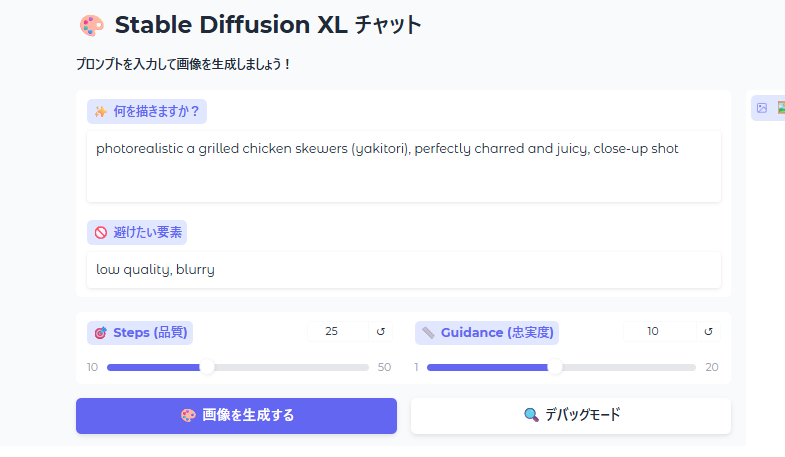
↓「まるで写真みたいな焼き鳥のイラストを描いてください」と依頼してみた。

おぉ~
なんか串の刺さり方がおかし気もするが...
かなりリアルな画像が作成されましたので大成功としましょう!!
【重要】エンドポイント削除を忘れずに!
SageMakerのエンドポイントは稼働中は料金が発生し続けるため、
継続課金を避けるため、テスト終了後は必ずエンドポイントを削除しましょう!!
【ml.g5.2xlargeだと、約$1.5/時間(約200円/時間)】
Amazon SageMakerのAWSマーケットプレイスのサブスクリプションは従量課金制なので
キャンセルしなくても料金はかかりません。
さいごに
今回のお話はいかがだったでしょうか。
気になった方はぜひSageMaker JumpStartで
画像生成AIを体験してみてくださいね!
それじゃあ、また~
半年前までCtrl+Cもわからなかった男
